NavSource Online: Submarine Photo Archive
Argonauts
Partial text on this page is from The Simon Lake Submarine Web Site
| Click On Image For Full Size | Size | Image Description | Source | |
|---|---|---|---|---|
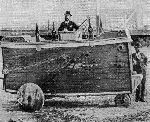 | 129k | The Argonaut Jr, was built by Simon Lake in 1894 of pitch pine, as inexpensive way to demonstrate his principles of submergence that would ultimately change the development of submarine technology. When submerged to a shallow seafloor, a diver's door could be opened and he could retrieve articles or exit & re-enter the little 14-foot submarine by maintaining a pressurized compartment. The Argonaut was named after the Argonaut sea creature, better known as the Portuguese man-o-war, because both could navigate on the surface, on the sea-floor, or anywhere in between. A novel feature of Simon Lake's early submarines was the use of wheels to keep the vessel from getting stuck to the bottom and to provide mobility by the use of interior hand cranks. The success of the demonstration amazed on-lookers at Atlantic Highlands NJ and inspired investors to support the establishment of The Lake Submarine Company in 1895 and to build a proper steel submarine vessel, the Argonaut I, by 1898. | Photos courtesy of Darryl L. Baker. | |
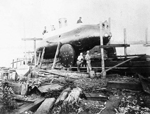 |
700k | Argonaut I, an early experiment in submarine design, has three wheels to draw it around the bottom of a river, lake, or sea. The design was not successful. | Photo & text courtesy of smithsonianmag.com via The Mariners' Museum / CORBIS. | |
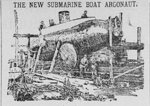 |
1.10k | THE NEW SUBMARINE BOAT ARGONAUT. Submarine navigation seems to be an accomplished fact. In the presence of a thousand persons the Argonaut, built by Simon Lake of Baltimore, was recently submerged in twenty feet of water and remained at the bottom of the Patapsco River for four hours. The craft behaved admirably, fulfilling all the requirements claimed by the Inventor. As the vessel lay at anchor she looked very much like a miniature monitor. Her decks were covered with water, only the hollow masts towering above, supplying air to those inside. After an exhibition of her going powers above water the little craft took up a position a short distance from shore, and in two minutes after coming to a standstill went to the bottom in twenty feet of water and cruised around at the will of those inside. The party which accompanied the inventor say they experienced no unpleasant sensation. The only time at which the motion of the vessel was felt was when rolling along on a hard bottom. Then there was a slight vibration. The test was a severe one, as much of the bottom was muddy. Nevertheless the boat plowed through without any trouble. When at a full stop a diver entered an air-tight compartment and made his wav out of the vessel. Those within were able to watch him as he moved about at the bottom of the river. A dinner was served under water, and the guests experienced no difficulty while eating. Three systems can be used for submerged traveling. With the masts, which are hollow, permitting air to come in on one side and go out the other, the vessel can work forty feet under water. In deeper water hose is used, which answers the purpose of supplying air to the gasoline engine, and also supplies the crew. In water 100 feet deep the storage battery is depended upon for power and light and the compressed air reservoir for the air supply. When the hollow masts are submerged and water pours in an automatic valve stops the flow. The diver obtains his supply of air from a tube running around the top of the vessel, which contains compressed air. He experienced no trouble either in going out or returning. |
Image and text provided by University of Hawaii at Manoa; Honolulu, HI. Photo & text by The Hawaiian Gazette.(Honolulu [Oahu, Hawaii]) 1865-1918, 25 February 1898, Image 6, courtesy of chroniclingamerica.loc.gov. |
|
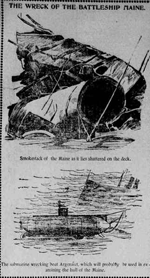 |
772k | THE WRECK OF THE BATTLESHIP MAINE The submarine wrecking boat Argonaut I which will probably be used in examining the hull of the Maine |
Image and text provided by University of North Texas; Denton, TX.
Photo from The Houston Daily Post (Houston, Tex.) 1886-1903, 24 February 1898, MAILABLE EDITION, Image 3, via chroniclingamerica.loc.gov. | |
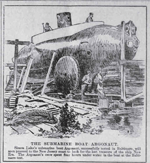 |
646k | THE SUBMARINE BOAT ARGONAUT Simon Lake's submarine boat Argonaut, successfully tested in Baltimore, will soon proceed to the New Jersey coast to look for the lost treasure of the ship New-Era. The Argonaut's crew spent four hours under water in the boat at the Baltimore test. |
Image and text provided by University of Hawaii at Manoa; Honolulu, HI. Photo & text by The Hawaiian Gazette. (Honolulu [Oahu, Hawaii]) 1865-1918, 25 February 1898, Image 6, courtesy of chroniclingamerica.loc.gov. | |
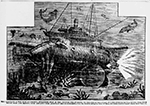 |
1.89k | SUCCESSFUL SUBMARINE BOAT IN THE COUNTRY FOR WORKING ON THE BED OF THE OCEAN, BUT THE FRENCH HAVE A DIVING BELL FROM WHICH THEY ARE GETTING GOOD RESULTS-THE ARGONAUT HAS SO DEMONSTRATED ITS WORTH OF LATE THAT IT WILL BE USED CONTINUALLY FROM THIS TIME ON. | Image and text provided by Montana Historical Society; Helena, MT. Photo from Daily Inter Mountain. (Butte, Mont.) 1881-1901, November 04, 1899, Image 11 via chroniclingamerica.loc.gov. |
|
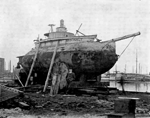 | 144k | The Argonaut I was built in 1897 in Baltimore at the Colombian Iron Works & Dry Dock to the dimensions of 36 feet in length and 9 foot beam, and powered by a 30 horsepower gasoline engine. In 1898 with a crew of 4 men, Simon Lake set out on a 2000 mile journey in the Chesapeake Bay and on the Atlantic coast, traveling both on the surface and submerged, and over all kinds of bottom, putting the Argonaut I to the test. Like a true-to-life Captain Nemo, Simon Lake and crew retrieved fish, clams and oysters through the dive compartment in order to demonstrate the practicality of living and traveling underwater. The 5 brave Argonauts survived violent storms in which over 200 surface vessels were lost, by traveling through the peaceful waters below. By the close of 1898, Simon and his Argonaut I achieved worldwide acclaim which was further complimented by the famous telegram sent by Jules Verne congratulating Simon in bringing the submarine's dreams to reality. December 1898, Simon brought his little Argonaut I to New York to be enlarged and re-outfitted with a variety of improvements including greater buoyancy, deck space, fuel capacity, a 60 HP engine and living quarters for a crew of eight. A searchlight was added in the bow to light up the fore-coming pathway, and telephones were installed throughout, so that conversation could be conducted between the divers and their tenders, with crew members stationed at different parts of the boat, with the surface or with the shore. | Photo from The American Submarine, by Norman Polmar, courtesy of Robert Hurst & fixed by Jim Kelling. | |
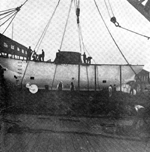 | 214k | Reconstructed by July 1900, the Argonaut II, was 66 feet in length and capable of making a non-stop sea voyage of 3000 miles, and submerging for 48 hours. The new Argonaut II looked quite different than the original one with the new raised deck that made the vessel appear more like a surface boat than a submarine. Simon Lake promoted the new Argonaut II by taking groups of people on an unforgettable journey to the bottom the Long Island Sound. One day there was 22 guests, another day, 28, who remained submerged for 4 hours while the crew obtained fresh seafood through the diver's compartment, prepared it and served a fine seafood dinner. Even though Simon Lake knew how to party, the submarine was designed for commercial use and had no military hardware what-so-ever. Peaceful purposes seemed much more equitable to Simon than producing war machines. He preferred searching the northeast coastal areas for sunken wrecks, to salvage their cargoes and claim the riches. He located numerous wrecks with the Argonaut II, and acquired extensive records of lost ships and cargoes, including some treasure ships. He had developed a lucrative career, making him a wealthy young man. He repeatedly demonstrated and promoted his patented submarine technology to the U.S. government as being safe and practical and would be quite suitable for military use with the addition of armaments. But Congress was attracted by the powerful political backing the Holland Company who were ready to build their designs. Simon Lake was offered several million dollars by Cuba for the Argonaut II , but Simon refused, wanting to serve his own country. | Photo from The American Submarine, by Norman Polmar, courtesy of Robert Hurst. | |
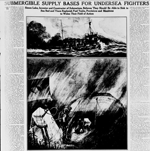 |
1.57k | SUBMERGIBLE SUPPLY BASES FOR UNDERSEA FIGHTERS Simon Lake, Inventor and Constructor of Submarines, Believes They Should Be Able to Sink to Sea Bed and There Replenish Fuel Tanks, Provisions and Munitions to Widen Their Field of Action While the torpedo boat destroyer is wracking herself to pieces and wearing out everybody aboard, rushing about hunting for the telltale glimpse of a submarine's periscope, the under water boat can be resting upon the bottom undisturbed and taking on supplies and munitions to lengthen the period of her sinister activities. |
Image and text provided by The New York Public Library, Astor, Lenox and Tilden Foundation. Photo & text by The Sun. (New York [N.Y.]) 1833-1916, 28 March 1915, FOURTH SECTION PICTORIAL MAGAZINE, Image 39, courtesy of chroniclingamerica.loc.gov. | |
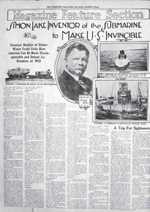 |
615k | THE SUBMARINE DISCUSSED BY ITS INVENTOR | Image provided by: Penn State University Libraries; University Park, PA. & University of Utah, Marriott Library.
Photo from Evening Public Ledger. (Philadelphia [Pa.]) 1914-1942, 31 August 1918, Image 10 & The Ogden Standard.(Ogden City, Utah) 1913-1920, 24 July 1915, Holiday Edition, MAGAZINE SECTION, Image 20 via chroniclingamerica.loc.gov. | |
 |
1.89k | SUBMARINE FISHING BOAT TO KEEP UP SEA FOOD SUPPLY Simon Lake's Latest Device Can Tap Unlimited Beds of Oysters and Clams and Salvage Wrecks |
Image and text provided by The New York Public Library, Astor, Lenox and Tilden Foundation. Photo from The Sun. (New York [N.Y.]) 1916-1920, 07 October 1917, Section 5 Special Feature Supplement, Image 52 via chroniclingamerica.loc.gov. |
|
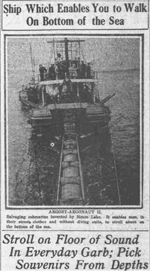 |
1.04k | Ship Which Enables You to Walk On Bottom of the Sea ARGOSY-ARGONAUT II Salvaging submarine invented by Simon Lake. It enables men in-their street clothes and without diving suits, to stroll about on the bottom of the sea. |
Image and text provided by Library of Congress, Washington, DC. Photo & text by The Washington Times (Washington [D.C.]) 1902-1939, 03 August 1919, FINAL EDITION, SECTION TWO, Image 20, courtesy of chroniclingamerica.loc.gov. | |
 |
588k | The Argonaut and the Argosy, daughter, both designed by Simon Lake, submarine for salvaging sunken treasure; the Argosy is attached by a hollow tube to the mother ship. The bottom of the Argosy opens to the sea which is held back on the diving bell principle by compressed air. | Image and text provided by Library of Congress, Washington, DC. Photo & text by New-York Tribune (New York [N.Y.]) 1866-1924, 10 August 1919, Image 49, courtesy of chroniclingamerica.loc.gov. |
|
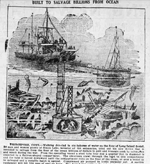 |
779k | BUILT TO SALVAGE BILLIONS FROM OCEAN | Image and text provided by University of Utah, Marriott Library. Photo & text by The Ogden Standard. (Ogden City, Utah) 1913-1920, 14 August 1919, LAST EDITION - 3:30 P.M., Image 7, courtesy of chroniclingamerica.loc.gov. | |
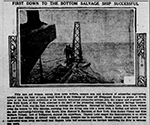 |
1.89k | Fifty men and women, among them news writers, camera men and students of submarine engineering, strolled along the floor of Long Island Sound in six fathoms of water off Bridgeport Harbor as guests of Simon Lake at his first public exhibition of his recently completed submarine salvage ship, the Argonaut and the Argosy. | Image and text provided by Ohio Historical Society, Columbus, OH. Photo & text by Perrysburg Journal. (Perrysburg, Wood Co., O. [Ohio]) 186?-1965, 28 August 1919, Image 3, courtesy of chroniclingamerica.loc.gov. |
|
Crew Contact And Reunion Information
Not Applicable to this Vessel
Additional Resources and Web Sites of Interest
WORLD SUBMARINE HISTORY TIMELINE 1580-2000
| Back To The Main Photo Index | Back To the Submarine Index |
|
Problems and site related matters, E-mail Webmaster |
|
This page is created and maintained by Michael Mohl & Darryl L. Baker. All Pages All Pages © 1996 - 2025 NavSource History. All rights reserved. |